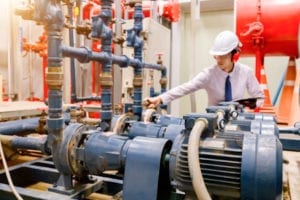Every year brings new challenges and nobody knows that better than facility managers. Facility managers need to do everything they can to ensure their facility runs smoothly, without any significant bumps along the way. One way to accomplish this is to have an effective industrial maintenance program in place. But where should you start?
The Steps Toward Ensuring Your Industrial Maintenance Program Runs Smoothly:
- Updating your current mechanical maintenance program.
- Aligning it with your facility’s procedures.
- Updating maintenance schedules for your equipment.
- And establishing service level agreements for your team.
If You Choose Not To Update Your Current Maintenance Program, Your Facility Will Run The Risk Of:
- Unexpected capital or facility expenses
- Equipment or machine failure
- Unanticipated downtime
Rasmussen Mechanical has been a key part of helping many facility managers improve their mechanical maintenance strategies. To help you be better prepared, we’ve developed a few budget-friendly strategies to strengthen your maintenance program.
1. Consult Your Industrial Maintenance Committee
Before any new maintenance program begins, decide who will be part of the process. A maintenance committee can consist of:
- Company executive
- Operations personnel
- Facilities management
- Maintenance managers
- Maintenance technicians
- Accounting or finance departments
Each one of the people within this committee serves a vital role in creating a successful Industrial maintenance program.
You will not always need input from every individual. However, drawing from a broad range of expertise will help you consider all sides of the business when making a decision. An operations expert may see things a technician could miss, while a facility manager can offer big picture ideas. The finance department can help validate the financial feasibility of the decision and company executives can get those ideas moving.


2. Check Your Equipment, Inventory, and Assets
Your equipment is a vital part of your business and the successful operation of your company. But, are you ensuring that you have all the necessary components accounted for in your mechanical maintenance program?
One of the most important aspects of updating any industrial maintenance program is improved tracking. This consists of going through every piece of equipment within your facility and taking an inventory. After that, track parts associated with each piece of equipment.
Take note of these specific assets as you construct your preventive plan:
- Make and model of the equipment
- Serial number
- Basic equipment specification and capabilities
- Asset number, brass tag number, or unit number
- Category (HVAC, boiler, air compressor, etc.)
- The location of the equipment
- The department who holds the responsibility for the equipment
- Condition of the equipment
- Any high-cost items of the asset
As you record the details of each item, it may be easier to look at preventive maintenance tracking software. This type of software allows facility managers to track the location of tagged equipment and assets. It then stores asset information, inventory data, and alert managers when spare parts are running low.
It’s essential to keep in mind that not every piece of equipment will go into your preventive plan. For instance, some parts may be too old or worn out to account for. If you aren’t sure which parts to add to your plan, ask yourself, “Is it a high priority asset?”. Here are additional factors to consider when deciding if you should include specific equipment in your industrial maintenance plan:
- Equipment repair or replacement costs are high
- Maintenance happens routinely
- The equipment is critical to your company’s success
Once you have addressed these factors, you will know all assets that are high-performing and set realistic operational goals.
Note: Mechanical equipment will never run at 100% average capacity.
3. Establish Industrial Maintenance Procedures
As you develop a maintenance program, you want all of your high-priority pieces of equipment on a maintenance schedule. By doing this, facility managers and teams will obtain a better understanding of the most critical tasks at hand for the year. It also helps determine the actions required to properly maintain the equipment and the frequency in which they should occur. Ultimately, the goal of your mechanical maintenance plan should be to prevent as many failures as possible.
To start, begin with one piece of equipment and create a schedule for the year. Next, create a maintenance checklist with daily, weekly, monthly, quarterly, bi-annual, and annual tasks based on the manufacturer’s recommendations. For instance, inspecting HVAC filters happen every three to four weeks, while changing them happen every three to six months.
Note: In some cases, you’ll have to schedule maintenance around run-time hours, depending on the equipment. If so, record each scheduling scenario and estimate the needed time to perform the specified task.
Facility managers can determine maintenance procedures based on prior corrective maintenance experiences or by referencing the manufacturer’s manuals and documented industry standards. From there, you can conduct a schedule of high to low priority items. This will help maintenance teams to assess which items rank higher than others.
Note: It’s best to schedule high-priority items immediately before distributing lower priority tasks to facility members.
Once your facility team completes their high priority items, schedule out the remainder of tasks with shorter intervals and more frequent cycles.
To stay consistent, budget time for emergency maintenance as well as performing other projects that will likely surface.
[Discover how preventive and predictive maintenance can have a significant impact on your facility’s equipment here!]
4. Train Your Team
Though developing a maintenance plan takes time, proper adoption of the program from the ENTIRE facility team is essential. After all, you wouldn’t want all that maintenance planning to go to waste. Make sure you talk to each facility member and demonstrate correct procedures for ongoing maintenance. You can lean on outside resources for easy to complete checklists to increase participation if needed. For example:
When dealing with boilers, you may want to deploy additional resources such as boiler checklists and logs for the successful maintenance of your systems. Resources such as this aid maintenance crews in lowering operational costs, reducing downtime, and guaranteeing the equipment is inspected, lubricated, and cleaned properly.
If you’re using a CMMS, implementation training is key. Companies must train core users on how to correctly input inventory items, maintain bill of materials and parts list, schedule maintenance procedures, and more.
Dedicating time to training employees on preventive maintenance tasks can be vital to ensuring the success of any maintenance program. It also will help employees understand “how” and “when” maintenance should be completed. With adequate training, employees learn to perform maintenance correctly, eliminate time-consuming trial and error, and prevent costly repairs.
5. Make Adjustments As You Go
When creating any preventive maintenance program, or plan in general, it’s important to ALWAYS analyze and assess the results. Most of the time, there’ll be kinks to hammer out to ensure your preventive maintenance program is the best it can be. You’ll also want to verify it’s providing the best ROI and efficiency for your mechanical equipment.
Industrial maintenance programs are something that should not be overlooked. Especially when they allow companies and employees to understand the ins and outs of their equipment. They also identify which equipment requires more attention, and aid in deciding when to replace systems.
That is why at Rasmussen Mechanical Services, we strive to help you see huge improvements in equipment performance and efficiency.
Above all, we’re here every step of the way to reduce unwarranted downtime, cut down repair costs, and enhance the lifespan of your systems. From service to sales to rentals, we have the expertise at hand to save you time, money, and energy. So, what are you waiting for? Contact us today or give us a call at 1-800-237-3141.



